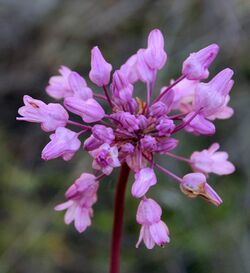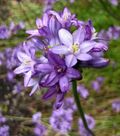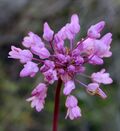Biology:Dichelostemma
| Dichelostemma | |
|---|---|

| |
| Dichelostemma volubile | |
| Scientific classification | |
| Kingdom: | Plantae |
| Clade: | Tracheophytes |
| Clade: | Angiosperms |
| Clade: | Monocots |
| Order: | Asparagales |
| Family: | Asparagaceae |
| Subfamily: | Brodiaeoideae |
| Genus: | Dichelostemma Kunth[1] |
| Type species | |
| Dichelostemma congestum (Sm.) Kunth[2]
| |
| Synonyms[2][3] | |
| |
Dichelostemma is a genus of North American plants closely related to the genus Brodiaea and sometimes regarded as part of that group.[4][5]
Dichelostemma is classified in the cluster-lily subfamily within the asparagus family.[6] in the latest Angiosperm Phylogeny Group classification (2009).[7] Older sources often placed it in the lily family; earlier versions of the APG classifications used the family Themidaceae.
The genus is native to the North America, especially in northern California , but also east to New Mexico and north to British Columbia and south into northwestern Mexico.[4][8]
These plants grow from perennial corms that produce a raceme or umbel-like inflorescence. The flowers are bell- or tube-shaped and produce capsules with black seeds. The name, from the Greek for "toothed crown", refers to the stamen appendages.
Diversity
| Image | Scientific name | Common Name | Distribution |
|---|---|---|---|
 |
Dichelostemma congestum (Sm.) Kunth | ookow or fork-toothed ookow. | Canada (BC), United States (WA OR California ) |
 |
Dichelostemma ida-maia (Alph.Wood) Greene | firecracker flower | United States (California OR) |
 |
Dichelostemma multiflorum (Benth.) A.Heller | round-tooth snake-lily, many-flower brodiaea and wild hyacinth | United States (California OR) |
 |
Dichelostemma volubile (Kellogg) A.Heller | twining snakelily and twining brodiaea. | United States (California OR) |
Dichelostemma capitatum (Benth.) Alph.Wood – blue dicks – has been moved to Dipterostemon capitatus.[10][11]
- Cultivars
- Dichelostemma 'Pink Diamond' - probably D. ida-maia × D. congestum (sometimes called Dichelostemma congestum).
References
- ↑ Kunth, Karl Sigismund. 1843. Enumeratio Plantarum Omnium Hucusque Cognitarum 4: 469–470 in Latin
- ↑ 2.0 2.1 Tropicos, Dichelostemma Kunth
- ↑ 3.0 3.1 Kew World Checklist of Selected Plant Families
- ↑ 4.0 4.1 Flora of North America, Vol. 26 Page 328 Dichelostemma Kunth, Enum. Pl. 4: 469. 1843.
- ↑ Jepson treatment
- ↑ Stevens, P.F., Angiosperm Phylogeny Website: Asparagales: Brodiaeoideae, http://www.mobot.org/mobot/research/apweb/orders/asparagalesweb.htm#Themidaceae
- ↑ Chase, Mark W.; Reveal, James L. (2009), "A phylogenetic classification of the land plants to accompany APG III", Botanical Journal of the Linnean Society 161 (2): 122–127, doi:10.1111/j.1095-8339.2009.01002.x
- ↑ 8.0 8.1 Biota of North America Program 2013 county distribution maps
- ↑ The Plant List search for Dichelostemma
- ↑ Dichelostemma capitatum (Benth.) Alph. Wood, University of California, https://ucjeps.berkeley.edu/cgi-bin/get_cpn.pl?22848, retrieved 2021-04-23
- ↑ "Dipterostemon capitatus (Benth.) Rydb.". Plants of the World Online. Royal Botanic Gardens, Kew. https://powo.science.kew.org/taxon/urn:lsid:ipni.org:names:82063-2.
Wikidata ☰ Q2707782 entry
 |

